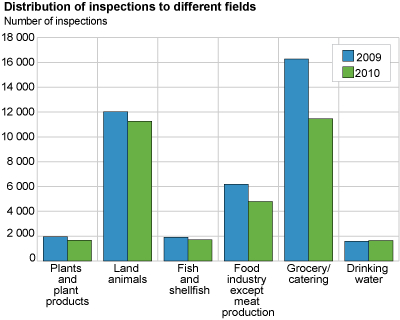Content
Published:
This is an archived release.
Most inspections related to food
In 2010, the Norwegian Food Safety Authority conducted 32 570 inspections in selected areas for plants, land animals, fish, drinking water and food. Over half of these inspections were carried out in relation to food.
The main activity in the Norwegian Food Safety Authority’s (NFSA) efforts to ensure safe food and drinking water, promote good plant health and the health and welfare of terrestrial animals and fish, is inspections. The figure of 32 570 inspections referred to here does not give the complete picture of the activity of the NFSA. The work related to food and drinking water is the largest area, with almost 18 000 inspections.
Fewer inspections
The number of inspections carried out decreased in most areas from 2009 to 2010. The largest reduction was in grocery stores and food catering. Although this food area had extensive supervisory activity in 2010, the decline was almost 30 per cent compared with 2009. This was because the NFSA allocated a lot of time and resources in 2010 to implementing an operating system for official control; MATS, and the decline was therefore as expected.
The number of samples for surveillance and control programmes for plants and fish remained relatively unchanged from 2009 to 2010. The number of samples related to animal health decreased by 25 per cent, whereas those for contaminants in food decreased by 15 per cent.
The reduction in samples related to animal health and contaminants in food was due to outbreaks of some serious animal diseases in 2009. Blue tongue disease in cattle, resistant salmon louse and swine flu generated more activity in some of the programmes. 2010 was less affected by such events; although some serious cases occurred, including an outbreak of e-coli.
Small increase in input
NFSA’s total expenditure in 2010 was NOK 1.3 billion, which represents an increase of 3.7 per cent from 2009. Wage costs amounted to 58 per cent, while purchases of goods and services accounted for 42 per cent of own production. In total, NFSA employed 1 300 contracted man-years adjusted for long-term leave in 2010; an increase of almost three per cent from the year before.
Exclusions from inspection statisticsThe 32 570 inspection visits referred to here do not include inspections of slaughtering and meat processing companies, animal health personnel and cosmetic inspections. |
Contact
-
Statistics Norway's Information Centre
E-mail: informasjon@ssb.no
tel.: (+47) 21 09 46 42

